©2009 Phillip D. Long and Richard Holeton. The text of this article is licensed under the Creative Commons Attribution-NonCommercial-NoDerivs 3.0 License (http://creativecommons.org/licenses/by-nc-nd/3.0/).
EDUCAUSE Review, vol. 44, no. 2 (March/April 2009): 36–49
Signposts of the Revolution?
What We Talk about When We Talk about
Learning Spaces
The afternoon sun was like a presence in this room, the spacious light of ease and generosity. We could have been anywhere, somewhere enchanted. —Raymond Carver, “What We Talk about When We Talk about Love”
In a recent vote, members of the EDUCAUSE community selected the “Top Teaching and Learning Challenges” for 2009:
- Creating learning environments that promote active learning, critical thinking, collaborative learning, and knowledge creation
- Developing 21st-century literacies (information, digital, and visual) among students and faculty
- Reaching and engaging today's learner
- Encouraging faculty adoption and innovation in teaching and learning with IT
- Advancing innovation in teaching and learning (with technology) in an era of budget cuts1
The overlap among these challenges testifies to an emerging consensus in the thinking about learning environments in higher education. On the other hand, the fact that they remain challenges hints at a larger failure to transcend the industrial model of education, the model that characterizes the vast majority of students’ experience on contemporary college and university campuses.
For the #1 challenge—“Creating learning environments that promote active learning, critical thinking, collaborative learning, and knowledge creation”—signs of progress proliferate. Below we will look at a few efforts that have resulted in such environments. These individual projects, possible signposts of the revolution, may show the way to replacing the industrial model with a model of inquiry. Unfortunately, they may also go almost unrecognized by the cultures in which they're found, because of a collective inability to achieve a common language with which to describe learning environments and their aspirations. To be transformative, the inquiry model must be embedded in a discourse and culture of inquiry—in language and practice that marry the needs of the twenty-first-century learner to the pedagogies of engagement and that connect those needs to actual learning environments. The question is: To what extent is the recent spate of learning space dialogue and construction also building a language that effectively makes these connections? What do we talk about when we talk about learning spaces?
The Industrial Model vs. the Inquiry Model
In this discussion, the elephant in the room is the industrial model of education. The industrial model, which emerged in the nineteenth and twentieth centuries, aimed to improve efficiency and to prepare young people for factory jobs requiring repetitive tasks. As a consequence, intended or not, the industrial model tended to preserve the status quo. The industrial model was further characterized by strict rules and regimented behavior, identical curricula and expectations for all students, and an emphasis on basic skills of literacy and numeracy.2
It's no coincidence, then, that the rhetoric of business came to permeate education. The name "superintendent" comes from the factory floor, as does language such as “production and productivity,” “outcome and output,” and “performance and success rates.” The crucible that forged the industrial model was partly responding to enormous pressures for scalable efficiencies, and although those pressures remain, a more refined rhetoric of business and management practice has evolved in recent decades. Promoting team-based approaches, enlightened and distributed leadership models, and learning-oriented philosophies, this new rhetoric has become ubiquitous in MBA programs as well as on best-seller lists.3 Today, we almost take for granted that education is a "business": we plan for "managing the enterprise," and we prepare students to be "informed consumers" of the "global information economy."
Regardless of the new rhetoric, the many progressive partnerships between business and education, and the now-common peer- and learner-centric approaches such as collaboration and lifelong learning, the industrial model continues to predominate in education, with age-determined grade levels (and the "rejects" who fail their grade level), standardized curricula, and uniform criteria for success. Standing in contrast is the inquiry model of education, reflecting the social-cognitive learning model in which learning is active, social, contextual, continuous, and holistic.4 It requires pedagogies of engagement, learning designs that connect students to knowledge-making activities and to one another (see Table 1).
Table 1. Characteristics of the Industrial and Inquiry Models
| Industrial Model | Inquiry Model | |
| Purpose of education |
|
|
| Learning model |
|
|
| Structure |
|
|
| Curriculum |
|
|
| Instruction |
|
|
| Assessment |
|
|
| Role of learner |
|
|
| Role of teacher |
|
|
| Role of parents |
|
|
| Role of administrator |
|
|
| Type of literacy required |
|
|
Source: Christine H. Leland and Wendy C. Kasten, “Literacy Education for the 21st Century: It's Time to Close the Factory,” Reading and Writing Quarterly, vol. 18 (2002), p. 13. Reprinted with permission.
The Twenty-First-Century Learner
To promote a shared discourse around inquiry and learning spaces in today's new media environment, we must also take into account the needs of twenty-first-century learners. As Randy Bass, of Georgetown University's Center for New Designs in Learning and Scholarship, asks: "How might we merge a culture of inquiry into teaching and learning with a culture of experimentation around new media technologies?"5 Michael Wesch, a cultural anthropologist, notes that "most of our classrooms were built under the assumption that information is scarce and hard to find" and were designed to reinforce the authority of the teacher in a world where knowledge is found, not made6—that is, the industrial model. Learning in new media environments, Wesch argues, requires us to rethink education and the student-teacher relationship. Existing physical structures (classrooms), aging social structures (standards, tenure and promotion systems), and outdated cognitive structures (information as "things" that must be in physical "places") must all be transformed. But if "spaces are themselves agents for change,"7 then we can't wait for the social and cognitive structures to evolve. We need to redesign spaces now for twenty-first-century learners.
As Wesch notes, "Nearly the entire body of human knowledge now flows through and around these [class]rooms in one form or another, ready to be accessed by laptops, cell phones, and iPods."8 Next-generation learning environments must account not only for the information revolution but also for an emerging revolution in how people work, collaborate, and conceive and construct knowledge. Today, in addition, learning activities must be accessible to a community across learners' lifetimes, not just as a right of passage to adulthood. Moreover, these activities must address the traditional academic disciplines as well as provide social and recreational support, all on a year-round, twenty-four-hour basis.
Developing a Common Language for Learning Space Design
Perhaps the most telling indicator of a change being integrated into a culture is the extent to which the rhetoric surrounding it evokes a common understanding or creates an effective discourse community. Many learning space design projects begin with a series of exercises designed to build mutual understanding among the architects, the planning and facilities managers, and the clients of the proposed space. Many of these people have not been involved in such a process before. Different techniques are used in an effort to achieve the shared understanding necessary to render a concept into a physical structure that supports its intended use. The process is fraught with difficulty, largely because the participants have different criteria or metrics for measuring success.
To bridge this chasm, several projects and studies have attempted to articulate principles to guide learning space design (see Table 2).9 The Joint Information Systems Council (JISC) of the United Kingdom described a set of principles in terms of adjectives such as "bold" and "creative." Peter Jaimeson added qualifications and more specificity to a similar set of principles. Diana Oblinger offered a direct approach, focused on the learner. And Scott Siddall led a learning space project that developed yet another set of principles, emphasizing practice and implementation.10
Table 2. Recent Learning Space Design Principles
| Source | Design Principles |
| JISC Learning Design Principles (2006) |
|
| Peter Jamieson (2005) |
|
| Diana Oblinger (2005) |
|
| Siddall et al. (2006) |
|
On the other hand, Chris Johnson and and Cyprien Lomas11 have suggested that each learning space design project must develop its own localized set of principles based on the institutional context and the particular learning goals of the project. Recalling the principles of good teaching practice developed by Arthur W. Chickering and Zelda F. Gamson and the challenge-based learning thesis developed in the National Research Council book How People Learn, Johnson and Lomas suggest that any pedagogically designed learning space must support the activities intended for the newly constructed building—and thus planners should derive a customized model that suits their project.
All model-based approaches favor those who are familiar with a particular model's forms of representation. An architect's model of the design and delivery process for a new learning space may mean little to the liberal arts faculty or academic staff member who is focused on the activities and experiences that the learning space can invoke. Therefore, a more promising approach would be to focus on what people do, on the actions and activities of a learning environment, rather than on the things. The things, after all, will frequently change over time. In terms of language, this means that designers should focus on verbs instead of nouns. Using the language of action, such an approach might entail developing a framework of questions to guide the design process as well as later assessment and evaluation.
What verbs do we care about, and how do they guide our thinking about design and space? Inquiry-based learning, an approach originally suggested by the work of John Dewey and further developed over the past twenty years, can provide a starting point.12 Table 3, for example, lists a set of inquiry verbs that are associated with various forms of active learning. These verbs of inquiry can clarify implications for the physical spaces where the learning activities are performed.
Table 3. Verbs of Inquiry for Learning
<>Designing processes for collecting data that will answer student-generated questions
| Verbs of Inquiry | Characteristics of Thought |
| Connecting new phenomena to students’ prior experience(s), allowing time for exploration and development of background knowledge |
|
|
|
| Investigating the natural world through the collection, organization, and display of data |
|
| Constructing meaning through analysis of patterns and trends in collected data that lead to the formulation of explanations; evaluation of quality of data and its usefulness in answering questions |
|
| Delivering information to others for their understanding |
|
| Practicing or rehearsing the line of thought and physical activity that represents the critical concepts and actions in a discipline |
|
| Discussing in a way that marshals ideas, artifacts, and logic to persuade others |
|
| Integrating what one has seen, done, heard, or read into a coherent intellectual framework |
|
Source: Rows 1-4 are from Amy Anderson and David Walbert, “Science as a Verb,” LEARN NC (University of North Carolina, School of Education), <http://www.learnnc.org/lp/pages/662>.
Tying together the inquiry model of education and the verbs of inquiry for learning is Benjamin Bloom's Taxonomy of Educational Objectives (1956), which was subsequently revised in 2000 in terms of action words. In 2008, Andrew Churches updated the revised taxonomy.13 Bloom's Digital Taxonomy (see Figure 1) expands the action vocabulary for describing thinking skills by incorporating the activities characterizing learner engagement with Web 2.0 tools. This digital taxonomy provides an excellent language for talking about the twenty-first-century intersection of physical and virtual learning environments—today's emerging learning spaces.
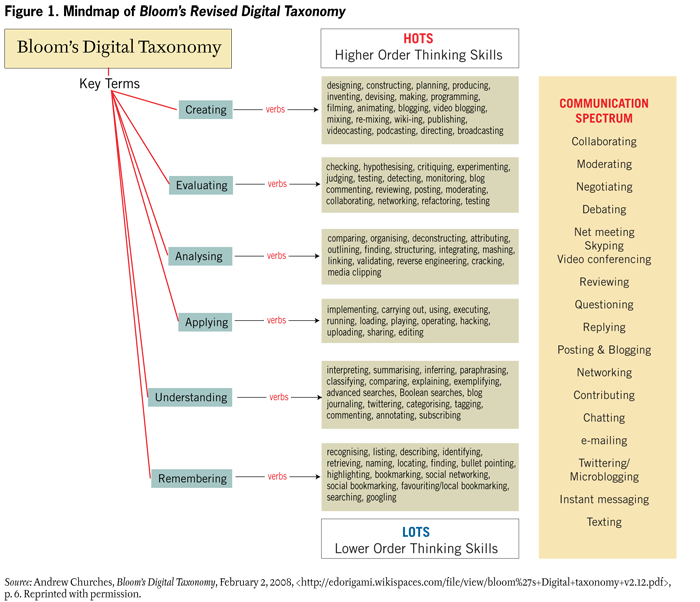
How are these principles expressed in specific cases? In the three illustrations below, we apply key terms from Bloom's Digital Taxonomy, as well as more concrete verbs from the detailed list of higher-order and lower-order thinking skills, to suggest how verbs of inquiry can connect activities and spaces.
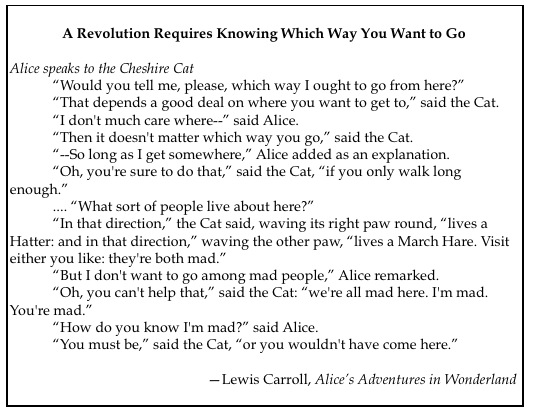
Republic Polytechnic, Singapore
Key verbs: [Evaluating] blog commenting, reviewing, posting, moderating, collaborating; [Analysing] linking, reverse engineering; [Applying] playing, sharing; [Understanding] categorising, annotating; [Remembering] social networking
Republic Polytechnic (RP) was founded in 2002 as the fifth polytechnic university in Singapore. But starting late may have significant advantages: the entire curriculum of the institution is focused on problem-based learning (PBL).14 RP’s physical campus reflects this pedagogical commitment.
RP’s teaching environment is based on small teams of students working in classes of twenty-five or fewer, with only a few large lecture or performance spaces for hosting communal gatherings. The small classes meet in one of eleven Learning Pods. Arguably the epitome of educational facilities where learning, dissemination, exchange, and resolution of information and ideas take place, RP’s Learning Pods also allow for programmatic zoning or for different combinations and permutations of labs, offices for facilitators, and study clusters.
Two elliptically aligned decks cut across the Learning Pods to form the Lawn and the Agora (see Figure 2). The Agora is a student-centered experimental public space—a large, continuous, sheltered informal meeting commons. The elevated Lawn, a public green that looks over surrounding greenery and an adjacent park, connects to the Agora through several access points. It serves as a social focal point much like Harvard Yard, Mills Yard at Cambridge University, and the open grounds at Oxford University.
Figure 2. A Learning Pod, the Lawn, and the Agora, Republic Polytechnic
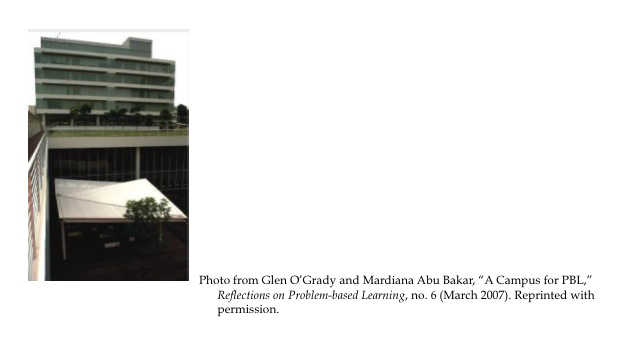
Those functions that require greater accessibility and mobility are located on the Lawn. These include the staff and student cafeterias, staff offices for PBL team facilitators, and various public amenities. Space is tight on this urban campus. By intersecting the Learning Pods and by layering on top of the Agora, the design minimizes traveling time. Connecting the Lawn above and the Agora below are openings to sunken courtyards, transparent glasses elevators and elevator lobbies, and the triple-volume glass enclosure for the library. The Lawn inclines with the terrain, minimizing the use of stairs and creating better accessibility for the variously-abled.
Fumihiko Maki, of Maki & Associates, conceived the campus plan. The central idea is that the “physical learning space for PBL must extend beyond the classroom . . . to break down the imaginary walls that separate learning from how we experience life, to create the sense that learning through problems is in essence what we do in the real world.”15 This thinking represents a departure from, if not an inversion of, typical informal learning space design, and the RP library is a prime example. In the library, spaces for collaboration and social problem solving are prioritized, while smaller spaces and corners are zoned for quiet reflection.
The entire RP campus was conceptualized around a vision of engaged pedagogies and was built accordingly. The pervasiveness of the design philosophy is not without its drawbacks, but the design represents one of the few instances of intentional pedagogy at the campus level.
The Collaborative Teaching and Learning Centre, University of Queensland
Key Verbs: [Creating] mixing, re-mixing; [Evaluating] blog commenting, moderating, collaborating, networking; [Analysing] mashing, linking; [Applying] playing, sharing editing; [Understanding] categorising, commenting, annotating; [Remembering] bullet pointing, bookmarking, searching, googling.
The Collaborative Teaching and Learning Centre (CTLC) at the University of Queensland (see Figure 3) is a suite of six innovative teaching and learning spaces that opened in 2005 to foster collaboration and critical thinking. It is designed to extend that collaboration both internally and externally through videoconferencing and access to grid technologies.
Two large spaces in the CTLC seat up to ninety students. Each space can be used as a large seminar space or can be divided up into five separate sections for working groups. These separations are afforded by clever dual use of drop-down electric screens, coordinated lighting changes, and audio cues that serve to redirect students’ attention to the new focus points. Thirty-six computers, providing a rough 3:1 student:PC ratio, encourage peer instruction and sharing. As has been learned from repeated examples of library commons, teaching, and independent study redesign efforts, having spacious surroundings and transparent visual access (selectively available) within and adjacent to a learning space is key to making the space comfortable in human terms. The working group or "pod mode" of operation can be dissolved by returning to seminar mode, which, besides simply raising the screens and changing the lighting, also allows the front podium to control the distribution of video content. Finally, for independent or student-initiated study, the room can operate as a learning commons, allowing for ad hoc group or individual use.
Figure 3. The Collaborative Teaching and Learning Centre (CTLC), University of Queensland
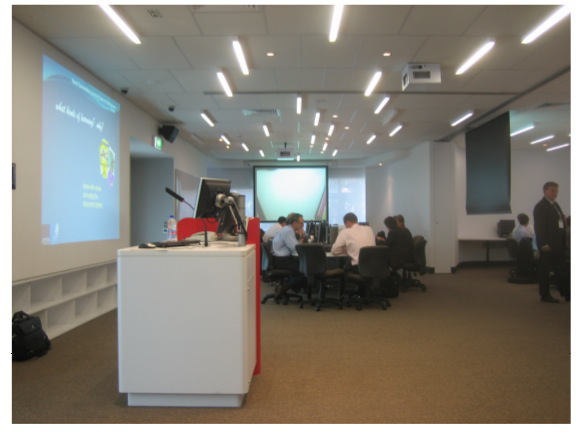
Photo by Phillip D. Long.
Two smaller spaces for twenty-five and forty students, respectively, are designed with the round tables in the middle, surrounded by a curved continuous bench on which the PCs sit. Again the space can be split into three smaller pods, each with a flat-panel screen, with the output from any one flat screen selectively displayed on the main room projection screen. As in the larger spaces, mini-document cameras are scattered among the PCs to project physical media.
Two H.323 videoconferencing seminar spaces round out the complement of CLTC rooms. They are designed to support video capture and transmission to remote sites or to connect the group at one site with a group at another site. This is enabled by replicating control of the videoconference functions from either the lectern or the central pod tables. Finally, one of the two videoconference rooms is also equipped as an Access Grid that can be used for multipoint video conferencing or, by sliding the wall on one side joined with one of the small-group collaborative spaces, to support larger classes or study sessions.
Academics who used the space for courses in Veterinary Science reported: "The dynamic was improved: the room allowed us to break into smaller groups and enable better interaction between the students and the staff (faculty)." And also: "The students haven't just been in the rooms, we've made use of the foyer areas and the outside terrace. Students responded well to using the space in different ways."16
Arroyo House Co-Lab, Wilbur Hall, Stanford University
Key Verbs: [Creating] programming, publishing; [Evaluating] reviewing, posting, collaborating, networking, testing; [Analysing] mashing, linking, validating, media clipping; [Applying] playing, hacking, sharing, editing; [Understanding] advanced searches, tagging, commenting; [Remembering] bullet pointing, bookmarking, social networking, searching, googling.
Arroyo House, part of the Wilbur Hall complex at Stanford University, is a residence for about ninety upper-class students. In 2006–7, Arroyo was designated as the Symbolic Systems and Related Majors Focus House. Symbolic Systems is an interdisciplinary program focusing on cognitive science, artificial intelligence, and human-computer interaction, with faculty from the departments of computer science, linguistics, philosophy, psychology, communication, and education. Focus houses are living-learning communities that feature intellectual themes and special programs, guided by the faculty resident fellow and student resident assistants and focus assistants. For residents, those intellectual themes are integrated with community-building activities, residential programs, and house and campus social life.
Currently, the resident fellow Todd Davies, associate director of Symbolic Systems, leads Arroyo's focus on "Mind and Intelligence." To promote collaboration around this interdisciplinary focus, and to create an in-house teaching space for small seminars, the office of Student Computing and other campus partners designed flexible spaces in Arroyo to support student residents working individually, in groups, and "on-the-go." Technology-rich spaces for partner and group work have been particularly lacking in the residences, where they are also needed for students who are engaged in extracurricular projects such as editing dorm videos and building websites for student organizations or in social activities such as gaming. A shared language among stakeholders emerged early, exemplified by Professor Davies's comment: "Twenty-first-century education is much more collaborative than when I was a student in the previous millennium, and dorm spaces like this are really needed."17 As Davies knows, his twenty-first-century students and dorm residents constantly mix academic work, community activities, and socializing in those physical (and virtual) spaces.
Dorm common areas are already available to the living-learning community twenty-four hours a day. The existing computer cluster was remodeled and reconfigured to accommodate the newly defined needs. First, the room was split, with about two-thirds of the space dedicated to an inner room. The outer room remains a mini-computer cluster with a printer, scanner, and public workstations. The inner room became the “CoLab,” visible through the newly constructed wall via a window, which creates a sense of transparency between the two spaces. The CoLab features three wheeled, collapsible tables that combine space efficiency, as-you-need-them surfaces, and sturdy design. Chairs are stackable. This design allows for small classes, informal study groups of varying size, and more community-focused projects (see Figure 4).
Whiteboards cover the walls, and "huddle boards" from Polyvision offer a lightweight, removable "mini-whiteboard" option for groups to meet in different parts of the room while still being able to display the mini boards on the larger board via a set of hooks that suspend them from rails. Finally, two 37-inch LCD displays allow students working in groups to plug in a laptop and share work without scrunching over each other's shoulders. These displays can be moved around the room on rolling Ergotron stands. Overall, the room offers a powerful combination of high- and low-tech tools, implemented so as to maximize their use while decreasing support needs.
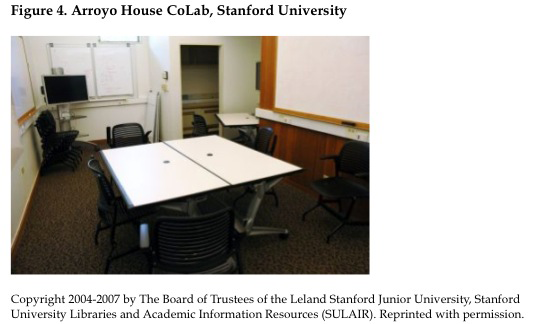
"The CoLab has often been occupied with students discussing projects or practicing presentations," says Davies.18 The CoLab hosts student-initiated seminars, house and community programs initiated by Davies or the student residence staff, and social activities like movies or gaming. Due to the popularity of the space, the Arroyo staff quickly instituted a reservation system, prioritizing group academic work over individual work and social activities.
Because of the reduced number of full-service computers available for individual work, two kiosk computers were installed in the high-traffic foyer—the lobby entrance area—of Arroyo. Intended for "quick-hit" access, the kiosks offer only a web browser and media players/readers, to attract students who might have used the cluster for only short periods of time or who want to do a quick Facebook or Google Maps check on the way in or out of the dorm. Thus the project is also an experiment with a twenty-first-century service model more adapted to "on-the-go" student life and mobile computing.
Implications for Future Learning Space Efforts
Lists of different design principles can be bewildering for practitioners beginning new building projects. Where should they start? We have suggested that it is helpful, even crucial, to define the important learning activities for spaces and to animate these activities by verbs of inquiry. From that language of action, practitioners can derive specific design parameters, building a matrix from verbs and their physical space implications. As a step in this direction, the Next Generation Learning Spaces group at the University of Queensland has developed a simple interrogative approach—called the Pedagogy-Space-Technology (PST) Design and Evaluation Framework—to help guide conversation among the disparate members of a building-project team.19 The intent is to enable all stakeholders to gain equal access to the design discussion and to reach a shared understanding through a simple question/answer framework (see Table 4).
Table 4. Pedagogy-Space-Technology Design and Evaluation Framework
| Focus | Conception & Design | Implementation & Operation |
| Overall | What is the motivation for the initiative? | What does success look like? |
| Pedagogy | What type(s) of learning and teaching are we trying to foster? Why? | What type(s) of learning and teaching are observed to take place? What is the evidence? |
| Space (including environs, furniture, and fittings) | What aspects of the design of the space and the provisioning of furniture and fittings will foster these modes of learning (and teaching)? How? | What aspects of the space design and equipment worked and which did not? Why? |
| Technology (ICT, lab, and specialist equipment) | How will technology be deployed to complement the space design in fostering the desired learning and teaching patterns? | What technologies were most effective at enhancing learning and teaching? Why? |
Reaching a shared understanding for the design of the learning space is critical. A learning space will shape what people do in it and, therefore, will promote or diminish certain types of learning. The architecture of spaces conveys messages about the expected use, the “built pedagogy” of rooms. Is Patrick Pouler writes: “Space is neither innocent nor neutral: it is an instrument of the political; it has a performative aspect whoever inhabits it; it works on its occupants. At the micro level, space prohibits, decides what may occur, lays down the law, implies a certain order, commands and locates bodies.”20 Viewed in this light, space either facilitates learning or hinders learning.
With few exceptions, today’s higher education institutions retain and perpetuate the dominant learning environments of the previous century. This industrial model may have been valuable and relevant for its time, but like previous paradigms, it has become outdated as the alignment between learning practice and traditional learning space design has diverged. The resulting tension has fueled creative efforts to design new learning environments, such as those described here, on campuses around the globe. These efforts—signposts of the revolution—replace the industrial model with the inquiry model of education, pointing to a path for the future. Following this path requires using a common language to describe learning environments and their aspirations. Only then will we know what we talk about when we talk about learning spaces.
- “Challenges 2009: The EDUCAUSE Top Teaching and Learning Challenges," [http://www.educause.edu/wiki/TLChallenges09]
- Christine H. Leland and Wendy C. Kasten, “Literacy Education for the 21st Century: It's Time to Close the Factory,” Reading and Writing Quarterly, vol. 18, no. 1 (January 2002), pp. 5–15.
- Arguably this movement dates from Armand Feigenbaum (Quality Control: Principles, Practice, and Administration [New York: McGraw-Hill, 1951]) and the development of Total Quality Management (TQM). A brief list of the more popular authors includes Robert Greenleaf ("servant leadership"), Jim Collins (“good to great” companies), Tom Peters (management excellence), Marcus Buckingham (great managers, discovering strengths), Stephen Covey (highly effective people), and Carol Dweck (the “growth mindset”).
- For example, see Ernest T. Pascarella and Patrick T. Terenzini, How College Affects Students: A Third Decade of Research, 2d ed. (San Francisco: Jossey-Bass, 2005); John D. Bransford, Ann L. Brown, and Rodney R. Cocking, eds., How People Learn: Brain, Mind, Experience, and School, National Research Council (Washington, D.C.: National Academy Press, 1999).
- Randy Bass, “New Media Technologies and the Scholarship of Teaching and Learning,” Academic Commons, January 7, 2009, <http://www.academiccommons.org/issue/january-2009> (italics in original).
- Michael Wesch, “A Vision of Students Today (and What Teachers Must Do),” Encyclopedia Britannica blog, October 21, 2008, <http://www.britannica.com/blogs/2008/10/a-vision-of-students-today-what-teachers-must-do/>.
- Joint Information Systems Committee (JISC), Designing Space for Effective Learning: A Guide to 21st Century Learning Space Design, 2006, p. 30, <http://www.jisc.ac.uk/media/documents/publications/learningspaces.pdf>, quoted in Diana G. Oblinger, “Space as a Change Agent,” in Diana G. Oblinger, ed., Learning Spaces (Boulder, Colo.: EDUCAUSE, 2006), <http://www.educause.edu/Chapter1.SpaceasaChangeAgent/11899>.
- Michael Wesch, “From Knowledgable to Knowledge-able: Learning in New Media Environments,” Academic Commons, January 7, 2009, <http://www.academiccommons.org/commons/essay/knowledgable-knowledge-able>.
- Phillip Long is indebted to the Next Generation Learning Spaces (NGLS) team members at the University of Queensland for bringing forward the juxtaposition of these efforts and for their insightful, ongoing conversation. NGLS team: David Radcliff, now at the Purdue University School of Engineering; Derek Powell, University of Queensland, ITS; Belinda Tibbetts, University of Queensland, ITS; and Hamilton Wilson, Wilson Architects, Brisbane, QLD, Australia.
- JISC, Designing Space for Effective Learning; Peter Jamieson, “Understanding a Happy Accident: Learning to Build New Learning Environments,” Report of ECE Research Project on Learning Communities (TEDI, University of Queensland, 2005); Diana G. Oblinger, “Leading the Transition from Classrooms to Learning Spaces,” EQ (EDUCAUSE Quarterly), vol. 28, no. 1 (2005), pp. 14–18, <https://er.educause.edu/articles/2005/1/leading-the-transition-from-classrooms-to-learning-spaces>; Scott E. Siddall, “Denison University Learning Spaces Project: Guiding Principles,” <http://www.denison.edu/academics/learningspaces/checkl.pdf>.
- Chris Johnson and Cyprien Lomas, “Design of the Learning Space: Learning and Design Principles,” EDUCAUSE Review, vol. 40, no. 4 (July/August 2005), pp. 16–28, <https://er.educause.edu/articles/2005/1/design-of-the-learning-space-learning-and-design-principles>.
- For example: John Dewey, Democracy and Education: An Introduction to the Philosophy of Education (1916; New York: Free Press, 1966); Jerome Bruner, Actual Minds, Possible Worlds (Cambridge: Harvard University Press, 1986); Howard S. Barrows, “Problem-Based Learning in Medicine and Beyond: A Brief Overview,” New Directions for Teaching and Learning, no. 68 (Winter 1996), pp. 3–12.
- Benjamin S. Bloom, Taxonomy of Educational Objectives, Handbook I: The Cognitive Domain (New York: David McKay Co., 1956); Lorin W. Anderson and David R. Krathwohl, eds., A Taxonomy for Learning, Teaching, and Assessing: A Revision of Bloom's Taxonomy of Educational Objectives (New York: Longman, 2001); Andrew Churches, Bloom's Digital Taxonomy, February 2, 2008, <http://edorigami.wikispaces.com/file/view/bloom%27s+Digital+taxonomy+v2.12.pdf>.
- Office of Academic Affairs, Republic Polytechnic, “Our Thinking,” <http://www.rp.sg/oaa/Our_Thinking.aspx>.
- Glen O’Grady and Mardiana Abu Bakar, “A Campus for PBL,” Reflections on Problem-based Learning, no. 6 (March 2007), <http://www.myrp.sg/ced/research/newsletter_pdf/rpnewsletter_issue6.pdf>.
- The Collaborative Teaching and Learning Centre, “The Next Generation Learning Spaces Project” (Australian Learning and Teaching Council, 2008).
- Davies quoted in Allan Chen and Rich Holeton, “Student Computing Creates New Residential ‘Collaboratory’ at Wilbur Hall,” Speaking of Computers, no. 74 (April 17, 2007), <http://speaking.stanford.edu/Back_Issues/SOC74/issue-computing.html#New_Arroyo_Collaboratory>.
- Ibid.
- David Radcliffe, “Designing Next Generation Places of Learning: Multidisciplinary Collaboration at the Pedagogy-Space-Technology Nexus,” session at Colloquium 2008, October 1, 2008, <http://www.uq.edu.au/nextgenerationlearningspace/designing-next-generation-places-of-learning>.
- Patrick Pouler, “Disciplinary Society and the Myth of Aesthetic Justice,” in Brenda Case Scheer and Wolfgang F. E. Preiser, eds., Design Review: Challenging Urban Aesthetic Control (New York: Chapman and Hall, 1994), pp. 175–86.
©2009 Phillip D. Long and Richard Holeton. The text of this article is licensed under the Creative Commons Attribution-NonCommercial-NoDerivs 3.0 License (http://creativecommons.org/licenses/by-nc-nd/3.0/).
